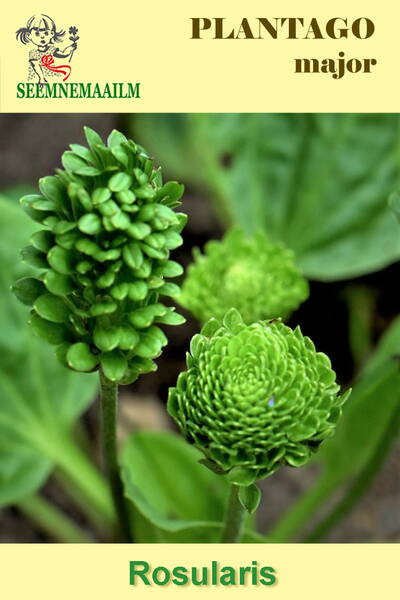Your shopping cart is empty!
Rose plantain "Rosularis" (ribwort, ripple-grass, waybread)
Greater plantain "Rosularis" (Bowles variety) - Plantago major.
A perennial plant of the Plantaginaceae family.
Special characteristics: unusual green leaf rosettes between large leaves, similar to mini-roses.
Natural flowering period: May - July.
Hardiness zones: Z3 - Z9.
Height of flowering plant: 25-35 cm.
It is distinguished by large dark green leaves of an ovoid-oblong shape with a wide wedge-shaped base, collected in a basal rosette.
On an erect powerful peduncle, instead of a panicle inflorescence, an apical rosette with a diameter of 5-9 cm is formed, resembling a rose flower, from many small green leaves. Over time, the almost flat "head" of the rosette at first stretches out in the center, becoming similar to a "fluffy" narrow pyramid. Almost no seeds are formed.
Use: for a rock garden.
The plant is undemanding in care, frost-resistant.
It looks decorative in a pot, but it can also be used as a ground cover plant.
The crop prefers well-lit or shaded areas and fertile soil of neutral or weak acidity (pH 5.5-7). However, plantain will also grow on other soils, it does not tolerate only extremely alkaline, as well as excessively heavy swampy areas. Pests and diseases practically do not affect this plant.
Plantain seeds are sown on the site before winter so that they undergo natural stratification (1.0 g = 3600 seeds).
They are placed in shallow furrows at a distance of about 30-50 cm from each other and sprinkled with a layer of soil at least 0.5 cm thick - in the spring you will see friendly shoots.
If you are going to sow plantain seeds in the spring, you will need a long preliminary cold stratification. Sow the seeds in the ground early, immediately after the soil has thawed and you have loosened it well to a shallow depth. Plantain crops do not need thinning, but weeds nearby should be removed, especially during the initial growth period of the crop. Caring for plantain is not difficult. From time to time, it is necessary to water the bushes, loosen the soil between them and, if desired (or on poor soils), feed the plants 2-3 times per season. Use nitrophoska or any other nitrogen fertilizer for rapid growth of vegetative mass. Plantain reproduces well by self-seeding (if you do not want this, then remove faded spikelets in time).
A perennial plant of the Plantaginaceae family.
Special characteristics: unusual green leaf rosettes between large leaves, similar to mini-roses.
Natural flowering period: May - July.
Hardiness zones: Z3 - Z9.
Height of flowering plant: 25-35 cm.
It is distinguished by large dark green leaves of an ovoid-oblong shape with a wide wedge-shaped base, collected in a basal rosette.
On an erect powerful peduncle, instead of a panicle inflorescence, an apical rosette with a diameter of 5-9 cm is formed, resembling a rose flower, from many small green leaves. Over time, the almost flat "head" of the rosette at first stretches out in the center, becoming similar to a "fluffy" narrow pyramid. Almost no seeds are formed.
Use: for a rock garden.
The plant is undemanding in care, frost-resistant.
It looks decorative in a pot, but it can also be used as a ground cover plant.
The crop prefers well-lit or shaded areas and fertile soil of neutral or weak acidity (pH 5.5-7). However, plantain will also grow on other soils, it does not tolerate only extremely alkaline, as well as excessively heavy swampy areas. Pests and diseases practically do not affect this plant.
Plantain seeds are sown on the site before winter so that they undergo natural stratification (1.0 g = 3600 seeds).
They are placed in shallow furrows at a distance of about 30-50 cm from each other and sprinkled with a layer of soil at least 0.5 cm thick - in the spring you will see friendly shoots.
If you are going to sow plantain seeds in the spring, you will need a long preliminary cold stratification. Sow the seeds in the ground early, immediately after the soil has thawed and you have loosened it well to a shallow depth. Plantain crops do not need thinning, but weeds nearby should be removed, especially during the initial growth period of the crop. Caring for plantain is not difficult. From time to time, it is necessary to water the bushes, loosen the soil between them and, if desired (or on poor soils), feed the plants 2-3 times per season. Use nitrophoska or any other nitrogen fertilizer for rapid growth of vegetative mass. Plantain reproduces well by self-seeding (if you do not want this, then remove faded spikelets in time).
Eng.: Common plantain, broad-leafed plantain, great plantain, greater plantain, rib-grass, ribwort, ripple-grass, waybread, white man's foot.












